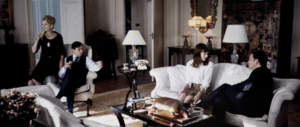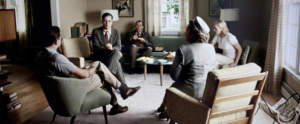He leaned out over the rail and peered up at the face of the building, carefully counting the balconies. As usual, though, the dimensions of the forty-storey block made his head reel. Lowering his eyes to the tiled floor, he steadied himself against the door pillar. The immense volume of open space that separated the building from the neighbouring high-rise a quarter of a mile away unsettled his sense of balance. At times he felt that he was living in the gondola of a ferris wheel permanently suspended three hundred feet above the ground. Nonetheless, Laing was still exhilarated by the high-rise, one of five identical units in the development project and the first to be completed and occupied. Together they were set in a mile-square area of abandoned dockland and warehousing along the north bank of the river.
The fivehigh-rises stood on the eastern perimeter of the project, looking out across an ornamental lake -- at present an empty concrete basin surrounded by parking-lots and construction equipment. On the opposite shore stood the recently completed concert-hall, with Laing’s medical school and the new television studios on either side. The massive scale of the glass and concrete architecture, and its striking situation on a bend of the river, sharply separated the development project from the run-down areas around it, decaying nineteenth-century terraced houses and empty factories already zoned for reclamation. For all the proximity of the City two miles away to the west along the river, the office buildings of central London belonged to a different world, in time as well as space. Their glass curtain-walling and telecommunication aerials were obscured by the traffic smog, blurring Laing’s memories of the past. Six months earlier, when he had sold the lease of his Chelsea house and moved to the security of the high-rise, he had travelled forward fifty years in time, away from crowded streets, traffic hold-ups, rush-hour journeys on the Underground to student supervisions in a shared office in the old teaching hospital.
Here, on the other hand, the dimensions of his life were space, light and the pleasures of a subtle kind of anonymity. The drive to the physiology department of the medical school took him five minutes, and apart from this single excursion Laing’s life in the high-rise was as self-contained as the building itself. In effect, the apartment block was a small vertical city, its two thousand inhabitants boxed up into the sky. The tenants corporately owned the building, which they administered themselves through a resident manager and his staff. For all its size, the high-rise contained an impressive range of services. The entire 10th floor was given over to a wide concourse, as large as an aircraft carrier’s flight-deck, which contained a supermarket, bank and hairdressing salon, a swimming-pool and gymnasium, a well-stocked liquor store and a junior school for the few young children in the block. High above Laing, on the 35th floor, was a second, smaller swimming-pool, a sauna and a restaurant. Delighted by this glut of conveniences, Laing made less and less effort to leave the building. He unpacked his record collection and played himself into his new life, sitting on his balcony and gazing across the parking-lots and concrete plazas below him. Although the apartment was no higher than the 25th floor, he felt for the first time that he was looking down at the sky, rather than up at it. Each day the towers of central London seemed slightly more distant, the landscape of an abandoned planet receding slowly from his mind. By contrast with the calm and unencumbered geometry of the concert-hall and television studios below him, the ragged skyline of the city resembled the disturbed encephalograph of an unresolved mental crisis.
J. G. Ballard, High-Rise, Jonathan Cape 1975
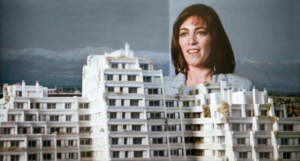
Yes, it could begin this way, right here, just like that, in a rather slow and ponderous way, in this neutral place that belongs to all and to none, where people pass by almost without seeing each other, where the life of the building regularly and distantly resounds. What happens behind the flats’ heavy doors can most often be perceived only through those fragmented echoes, those slinters remnants, shadows, those first moves or incidents or accidents that happen in what are called “common areas”, soft little sounds damped by the red woolen carpet, embryos of communal life which never go further than the landing. The inhabitants of a single building live a few inches from each other, they are separated by a mere partition wall, they share the same spaces repeated along each corridor, they perform the same movements at the same times, turning on a tap, flushing the water closet, switching on a light, laying the table, a few dozen simultaneous existences repeated from storey to storey, from building to building, from street to street. They entrench themselves in their domestic dwelling space – since that it what it is called – and they would prefer nothing to emerge from it; but the little that they do let out – the dog on a lead, the child off to fetch the bread, someone brought back, someone sent away – comes out by way of the landing. For all that passes, passes by the stairs, and all that comes, comes by the stairs: letters, announcements of births, marriages, and deaths, furniture brought in or taken out by removers, the doctor called in an emergency, the traveller returning from a long voyage. It’s because of that teh staircase remains an anonymous, cold, and almost hostile place. In old buildings there use to be steps, wrough-iron handrails, sculptures, lamp-holders, sometimes a bench to allow old folk to rest between floors. In modern buildings there are lifts with walls covered in would-be obscene graffiti, and so-called “emergency” staircases in unrendered concrete, dirty and echoing. In this block of flats, where there is an old lift almost always out of order, the staircase is an old-fashioned place of questionalble cleanliness, which declines in term of middle-class repectability as it rises from floor to floor: two thicknesses of carpet as far as the third floor, thereafter only one, and none at all for the two attic floors. Yes, it will begin here: between the third and the fourth storey at 11 Rue Simon-Crubellier.
Georges Perec, Life. A Users’s Manual, Vintage Books, p. 3-4.
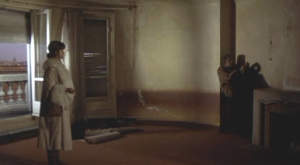
Our room and half was part of a huge enfilade, one-third of a block in lengh, on the northern side of a six-story building that faced three streets and a square at the same time. The building was one of those tremendous cakes in so-called Moorish style that in Northern Europe marked the turn of the century. Erected in 1903, the year of my father’s birth, it was the architectural sensation of the St. Petersburg of that period, and Akhmatova once told me that her parents took her in a carriage to see this wonder. On its western side, facing one of the most famous avenues of Russian literature, Liteiny Prospect, Alexander Blok had an apartment at one time. As for our enfilade, it was occupied by the couple that dominated the pre-revolutionary Russian literary scene as well as the intellectual climate of Russian emigration in Paris later on, in the twenties and the thirties (...).
After the Revolution, in accordance with the policy of “densening up” the bourgeoisie, the enfilade was cut up into pieces, with one family per room. Walls were erected between rooms – at first of plywood. Subsequently, over the years, boards, brick, and stucco would promote these partition to the status of architectural norm. If there is an infinite aspect to space, it is not its extension but its reduction. If only because the reduction of space, oddly enough, is always more coherent. It’s better structured and has more names: a cell, a closet, a grave. Expanses have only a broad gesture. In the U.S.S.R., the living quarters’ minimum per person is 9 square meters. We should have considered ourselves lucky, because due to the oddity of our portion of the enfilade, the three of us wound up with a total of 40 meters. That excess had to do also with the fact that we had obteined this place as the result of my parent’s giving up teh two separete rooms in different part of town in which they have lived before they got married. This concept of exchange – or, better still, swap (because of the finality of such exchange) – is something there is no way to convey to an outsider, to a foreigner. Property laws are arcane everywhere, but some of them are more arcane than others, especially when your landlord is the state. Money has nothing to do with it, for istance, since in a totalitarian state income brackets are of no great variety – in other words, every person is as poor as the next. You don’t buy your living quarters: at best, you are entitled to the square equivalent of what you had before.
Joseph Brodsky, Less than One, Farrar Straus Giroux, p. 451-453.
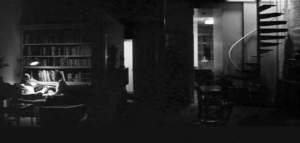
The palace of gold, or of the sharks, if you prefer, was there: five floors plus mezzanine. Worm-eaten and gray. to judge by that grim dwelling and its cohort of windows, the sharks must have been a myriad: little sharks with yawning stomachs, that‘s for sure, but easily satisfied esthetically. Living underwater on appetites and phagoc sensations in general, the graynes, the lofty opalescence of then days was light, for them: that little bit of light which was all thery needed. As to the gold, well, yes, maybe it didhave gold and silver. On eof those big buildings costructed at the beginninig of the century which fill you at first sight with a sense of boredom and canarified contrition: you know, the precise opposite of the color of Rome, of the sky and the gleaming sun of Rome. Ingravallo, you might say, knew it by heart: and in fact, a slight palpitation seized him, as with the two policemen he approached the familiar structure, in his official, investigative role.
In front of the big, louse-coloured building: a crowd: circumfused by a protective net of bycicles. Women, shopping bags, and celery stalks: a shopkeeper or two from across the street, inhis white apron: an “odd job“ man, also in his apron, striped his nose the shape and color of a wondrous pepper: concierges, maids, the little daughters of the cocierges shouting “Peppiiino!“ to boys with hoops, a batman satured with oranges trapped in his great net bag, and crowned by ferns of two big fennels, and packages: two or three important officials, who in that hour ripe for the higher ranks seemed to have unfurled their sails: bound, each of them, for his personal Ministry: and a dozen or even fifteen idlers, headed in no direction at all. A letter carrier in a state of advanced pregnancy, more curious than all, with his brimmimg bag which smacked everyone in the ass: some muttered goddamnit, and then goddamn, goddamn, one after the other, as the bag struck them, in turn, on the behind. A gamin, with Tiberine seriousness, said: “This building here, inside it, there‘s more gold than there is garbage.“ All around the stripe of the bycicle wheels, like a sui generis skin, seemed to render impenetrable that collective pulp.
(...) Ingravallo, followed by the concierge herself and by the other two, as well as by the comments of all, “the cops, the cops“, climbed up to the third floor, stairway A, where the robbed woman lived. Below, the great chattering continued: the unleashed, fluted voices of the females, emulated by an occasional masculine trombone, which from time to time even drowned them out: like the cows‘ bent cervixes by the bull‘s great horns: the crowd‘s minds gathered the clover of the initial eyewitness accounts, of the “I swear I saw him‘s“; began to weave them into an epic. It was a robbery, or to be more precise, a case of breaking and entering, manu armata.
Carlo Emilio Gadda, That awful mess on the via Merulana, nyrb, pp. 22-24.
I pull up to Lauren‘s apartment at the Silk Building right above Tower Records where I saw her earlier this afternoon and as I roll the Vespa up to the lobby the teenage doorman with the cool shirt picks up a phone hesitantly, nodding as Russell Simmons walks past me and out onto Fourth Street. (...) The elevator doors slide open and I lean the bike in the hallway just outside Lauren‘s apartment. Inside: all white, an Eames folding screen, an Eames surfboard table, the roses I saw in Damien‘s office lie on a giant Saarinen pedestal surrounded by six tulip chairs. MTV with the sound off on a giant screen in the living room: replays of today‘s shows, Chloe on a runway, Chandra North, other models, ABBA‘s “Knowing Me, Knowing You“ coming from somewhere. (...) She walks past me, down a hallway covered with a Berber-style woven carpet and Moroccan embroidered pillows stacked against the walls and then I‘m in her bedroom, where I flop on the bed, leaning back on my elbows, my feet barely touching the floor, watching as Lauren stalks into the bathroom and begins toweling her hair dry. Behind her a poster for some indie film starring Steve Buscemi hangs above the toilet.
Breat Easton Ellis, Glamorama, Knopf, pp. 229-232
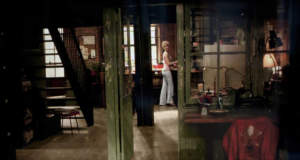
She turned on to the Shin-Oume Expressway and drove toward the city for a few minutes before turning right in the direction of Kunitachi. Beyond the pear orchards on the left, a tight cluster of old apartment blocks came into view. The place Kuniko called home. She pulled the Golf into her designated space in the parking lot. The other cars were all sub-compacts, all domestic. Feeling particularly pleased with her own imported model, she closed the door with a loud slam. Serves them right if it wakes somebody. Still, if one of the neighbours started shouting, she knew she’d be forced to offer an apology. For the time being, she had to make do here as best she could. She rode up to the fifth floor in the graffiti-covered elevator and then picked her way down the passage strewn with tricycles and Styrofoam boxes to her own apartment. As she unlocked the door and let herself into the darkened room, she could hear a harsh snore, like the sound of an animal sleeping in there; but she was so used to the sound, she barely noticed it. She pulled the morning paper from the mailbox and put it on the dining-room table they’d bought on credit.
The room was warm and humid. She turned on the air conditioner and opened the refrigerator. She could never get to sleep, as hungry as she was, but there was nothing to eat. Angry now, Kuniko yanked at the tab on a can of beer. Opening a bag of snack cakes, she turned on the television, changed the channel to a morning talk show, and sat back to listen to the celebrity gossip while she waited for the beer to take effect.
Natsuo Kirino, Out, Vintage, 2005.
(...) Then we headed down Manzanillo, turned onto Aguascalientes, and turned south again onto Medellin, walking until we reached Calle Tapeji. We stopped in front of a five-storey building and Pancho invited me to have lunch with his family. We took the elevator up to the top floor.
There, instead of going into one of the apartments, as I had expected, we climbed the stairs to the roof. A gray sky, but bright as if there had been a nuclear attack, welcomed us in the middle of a vibrant profusion of flowerpot and plants spilling into the passage-ways and laundry space. Pancho’s family lived in two rooms on the roof.
(...) One room served as dining and TV room during the day, and as Pancho, Moctezuma, and Norberto’s bedroom at night. The other was a kind of giant closet or wardrobe, which held the refrigerator, the kitchen supplies (they brought the portable stove out into the hallway during the day and put it back inthe room at night), and the mattress where Doña Panchita slept.
(...) Unlike the two rooms occupied by the Rodriguezes, Luscious Skin’s room was a model of a bare austherity. I didn’t see clothes strewn around, I didn’t see household things, I didn’t see books, (...) just a thin mattress and a chair – no table – and a nice leather suitcase where he kept his clothes.
Roberto Bolaño, The Savage Detectives, Picador, p. 65-66.
